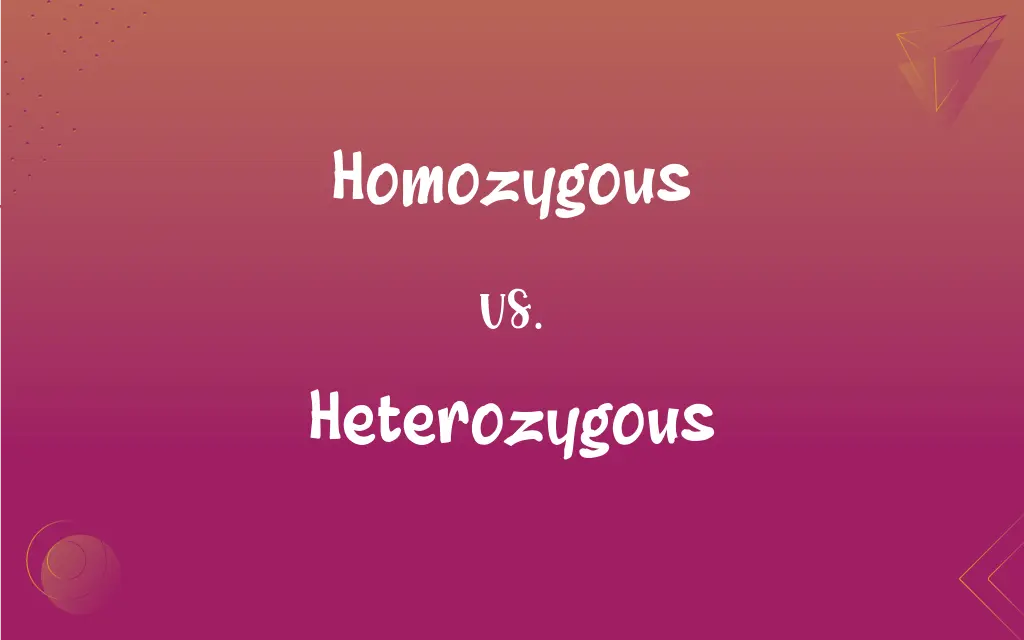Homozygous vs. Heterozygous: What's the Difference?
Edited by Janet White || By Harlon Moss || Updated on October 19, 2023
Homozygous means having two identical alleles for a trait; heterozygous means having two different alleles for a trait.

Key Differences
In genetics, when an individual is described as homozygous for a particular trait, it signifies that they possess two identical alleles for that specific gene. This could be two dominant alleles (homozygous dominant) or two recessive alleles (homozygous recessive). Conversely, being heterozygous implies that the individual carries two different alleles for that gene, one dominant and one recessive.
When considering the physical expression or phenotype of a trait, a homozygous individual will consistently display the trait associated with the alleles they carry. For instance, someone who is homozygous dominant or homozygous recessive for a gene that influences eye color will exhibit the color associated with those alleles. In contrast, a heterozygous individual may display the trait associated with the dominant allele, even though they carry one recessive allele.
In terms of inheritance, homozygous parents tend to produce offspring that are also homozygous, as they can only pass on one type of allele for that trait. This predictability in offspring phenotype is what makes homozygous organisms crucial in genetic studies. Heterozygous parents, on the other hand, have the potential to produce offspring that are either homozygous or heterozygous, depending on the allele combinations.
Genetic diversity is influenced by the presence of homozygous and heterozygous genes within populations. A high proportion of homozygous genes might indicate inbreeding and could lead to a decreased ability to adapt to environmental changes. Heterozygous populations, having genetic variability, are often more resilient to environmental changes and diseases.
In medical genetics, being homozygous or heterozygous for certain genes can determine susceptibility to specific diseases or conditions. For instance, being homozygous for a mutation might result in a disease, whereas being heterozygous might result in being a carrier without showing symptoms.
ADVERTISEMENT
Comparison Chart
Allele Type
Two identical alleles.
Two different alleles.
Phenotype Expression
Consistent with the carried alleles.
Typically aligned with the dominant allele.
Inheritance
Typically produces homozygous offspring.
Can produce both homozygous and heterozygous offspring.
Genetic Diversity
May indicate limited genetic variability.
Indicates greater genetic variability.
Medical Implications
Homozygous mutations can lead to diseases.
Heterozygous might result in being a carrier.
ADVERTISEMENT
Homozygous and Heterozygous Definitions
Homozygous
Possessing two identical alleles for a specific gene.
She is homozygous for the blue eye color gene, so she has blue eyes.
Heterozygous
Carrying two different alleles for a specific gene.
He is heterozygous for the height gene, carrying both tall and short alleles.
Homozygous
A genetic condition where both alleles of a gene pair are the same.
Due to his homozygous status, he had a higher risk of the inherited disease.
Heterozygous
A genetic state where alleles of a gene pair differ.
Her heterozygous genes made her a carrier of the trait but not an expresser.
Homozygous
An unvarying genetic state for a particular gene's expression.
Her homozygous condition ensured her offspring would inherit the trait.
Heterozygous
A combination of dominant and recessive genes for a particular characteristic.
Being heterozygous for the trait, she displayed the dominant phenotype.
Homozygous
An organism with matching pairs of genes for a particular trait.
The pea plant was homozygous and consistently produced yellow peas.
Heterozygous
An organism with non-matching pairs of genes for a trait.
The flower was heterozygous, resulting in a mix of colors in its offspring.
Homozygous
Representing uniformity in genetic makeup for a specific trait.
As a homozygous dominant plant, it always displayed the dominant phenotype.
Heterozygous
Representing genetic diversity for a specific trait's expression.
As a heterozygous individual, he had a varied genetic makeup.
Homozygous
Having the same alleles at a particular gene locus on homologous chromosomes.
Heterozygous
Having different alleles at one or more corresponding chromosomal loci.
Homozygous
Of an organism in which both copies of a given gene have the same allele
Heterozygous
Of or relating to a heterozygote.
Homozygous
Having identical alleles at corresponding chromosomal loci;
These two fruit flies are homozygous for red eye color
Heterozygous
Of an organism which has two different alleles of a given gene.
Heterozygous
Having dissimilar alleles at corresponding chromosomal loci;
Heterozygous for eye color
FAQs
How does homozygous differ from heterozygous in terms of alleles?
Homozygous has two identical alleles, while heterozygous has two different alleles.
What does homozygous mean?
Homozygous refers to having two identical alleles for a particular gene.
Can heterozygous individuals display recessive traits?
No, heterozygous individuals typically display the dominant trait.
Are heterozygous individuals always carriers?
Heterozygous individuals are carriers if the trait in question is recessive.
Are there health implications associated with being homozygous or heterozygous?
Yes, certain diseases or conditions can be influenced by one's homozygous or heterozygous status.
Is it possible for a trait to be both homozygous and heterozygous?
A trait can't be both in one individual, but across a population, both conditions can exist.
What role does homozygosity play in inbreeding?
Inbreeding increases homozygosity, which can lead to a rise in inherited diseases.
How can I determine if I'm homozygous or heterozygous for a gene?
Genetic testing can reveal if an individual is homozygous or heterozygous for specific genes.
Can an organism be homozygous for some traits and heterozygous for others?
Yes, an organism can be homozygous for certain genes and heterozygous for others.
What is the definition of heterozygous?
Heterozygous means possessing two different alleles for a specific gene.
Can homozygous conditions increase susceptibility to diseases?
Yes, being homozygous for certain mutations can lead to specific diseases.
Can homozygous dominant individuals show the recessive phenotype?
No, homozygous dominant individuals always express the dominant phenotype.
How do homozygous genes impact genetic studies?
Homozygous genes offer predictability in offspring phenotype, making them crucial for genetic studies.
Can a heterozygous individual exhibit symptoms of a genetic disease?
Typically, heterozygous individuals are carriers without symptoms, but exceptions exist.
Are there advantages to being heterozygous for certain genes?
Yes, being heterozygous can offer protection against some diseases, such as sickle cell anemia.
Does homozygous always mean dominant?
No, homozygous can be either dominant or recessive, based on the alleles present.
Can a homozygous individual be a carrier of a trait?
No, homozygous individuals either express the trait or don't, but they can't be carriers.
Which is more common in natural populations: homozygous or heterozygous individuals?
Heterozygous individuals are typically more common due to the mixing of genes over generations.
What do two heterozygous parents typically produce in terms of offspring?
Two heterozygous parents can produce homozygous and heterozygous offspring.
Why is genetic diversity often linked with heterozygosity?
Heterozygosity indicates genetic variability, enhancing adaptability and resilience.
About Author
Written by
Harlon MossHarlon is a seasoned quality moderator and accomplished content writer for Difference Wiki. An alumnus of the prestigious University of California, he earned his degree in Computer Science. Leveraging his academic background, Harlon brings a meticulous and informed perspective to his work, ensuring content accuracy and excellence.
Edited by
Janet WhiteJanet White has been an esteemed writer and blogger for Difference Wiki. Holding a Master's degree in Science and Medical Journalism from the prestigious Boston University, she has consistently demonstrated her expertise and passion for her field. When she's not immersed in her work, Janet relishes her time exercising, delving into a good book, and cherishing moments with friends and family.































































